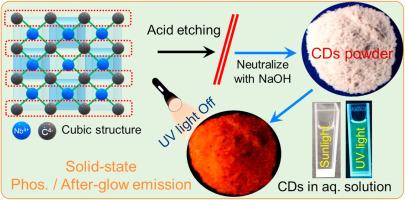Room temperature red phosphorescence enabled by alkali treatment in niobium carbide-derived carbon dots
IF 3.6
3区 物理与天体物理
Q2 OPTICS
引用次数: 0
Abstract
Room temperature phosphorescence (RTP) and afterglow emission in carbon dots (CDs) are typically achieved by embedding them into rigid external matrices to suppress vibrational relaxation. However, matrix dependence limits their practical utility. Herein, we demonstrated a simple solution-based acid-etching method to introduce a matrix-free approach for RTP and afterglow emission in CDs. Acid treatment cleaves metal-carbon bonds, forming well-defined CDs that, after alkali neutralization, exhibit strong blue fluorescence in solution. Upon solidification, the CDs emit yellowish-green fluorescence and red afterglow, lasting ∼1 s, without any additional matrix. CDs obtained directly from acidic or neutral conditions show no observable phosphorescence. Time-resolved area-normalized emission spectroscopy reveals that alkaline conditions promote surface rigidity and interchromophoric interactions, enhancing intersystem crossing and suppressing aggregation-induced quenching. This work demonstrates a robust, matrix-free approach for CD RTP with promising solid-state photonic and security applications.

碱处理使碳化铌衍生的碳点产生室温红色磷光
碳点(cd)的室温磷光(RTP)和余辉发射通常是通过将其嵌入刚性外部矩阵以抑制振动弛豫来实现的。然而,矩阵依赖性限制了它们的实际应用。在此,我们展示了一种简单的基于溶液的酸蚀刻方法,为CDs中的RTP和余辉发射引入了无基体的方法。酸处理会切割金属-碳键,形成定义明确的CDs,在碱中和后,在溶液中表现出强烈的蓝色荧光。固化后,CDs发出黄绿色荧光和红色余辉,持续约1s,不需要任何额外的基质。直接从酸性或中性条件下得到的CDs没有可观察到的磷光。时间分辨区域归一化发射光谱显示,碱性条件提高了表面硬度和显色相互作用,增强了系统间的交叉,抑制了聚集引起的猝灭。这项工作展示了一种强大的、无矩阵的CD RTP方法,具有很好的固态光子和安全应用前景。
本文章由计算机程序翻译,如有差异,请以英文原文为准。
求助全文
约1分钟内获得全文
求助全文
来源期刊

Journal of Luminescence
物理-光学
CiteScore
6.70
自引率
13.90%
发文量
850
审稿时长
3.8 months
期刊介绍:
The purpose of the Journal of Luminescence is to provide a means of communication between scientists in different disciplines who share a common interest in the electronic excited states of molecular, ionic and covalent systems, whether crystalline, amorphous, or liquid.
We invite original papers and reviews on such subjects as: exciton and polariton dynamics, dynamics of localized excited states, energy and charge transport in ordered and disordered systems, radiative and non-radiative recombination, relaxation processes, vibronic interactions in electronic excited states, photochemistry in condensed systems, excited state resonance, double resonance, spin dynamics, selective excitation spectroscopy, hole burning, coherent processes in excited states, (e.g. coherent optical transients, photon echoes, transient gratings), multiphoton processes, optical bistability, photochromism, and new techniques for the study of excited states. This list is not intended to be exhaustive. Papers in the traditional areas of optical spectroscopy (absorption, MCD, luminescence, Raman scattering) are welcome. Papers on applications (phosphors, scintillators, electro- and cathodo-luminescence, radiography, bioimaging, solar energy, energy conversion, etc.) are also welcome if they present results of scientific, rather than only technological interest. However, papers containing purely theoretical results, not related to phenomena in the excited states, as well as papers using luminescence spectroscopy to perform routine analytical chemistry or biochemistry procedures, are outside the scope of the journal. Some exceptions will be possible at the discretion of the editors.
 求助内容:
求助内容: 应助结果提醒方式:
应助结果提醒方式:


